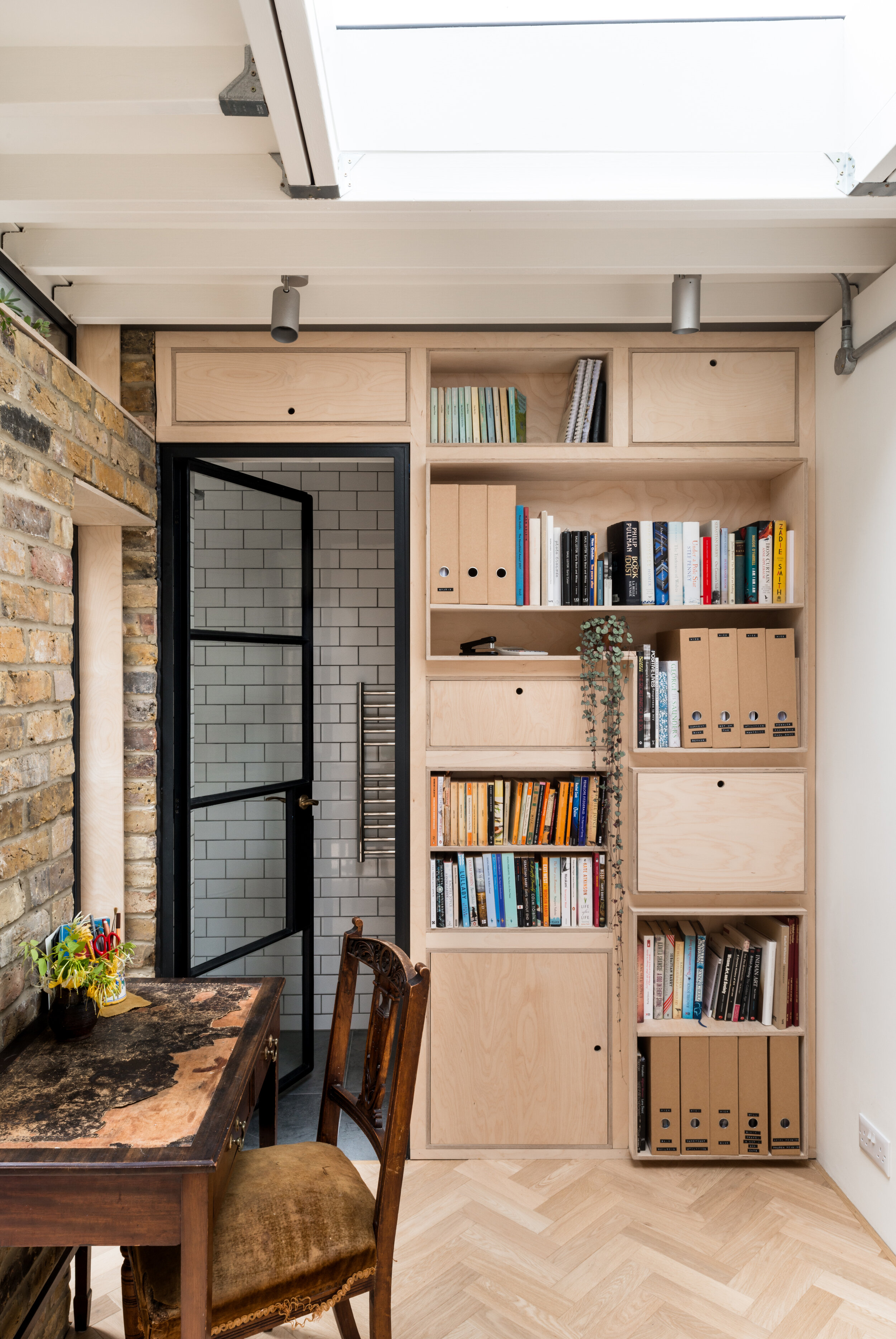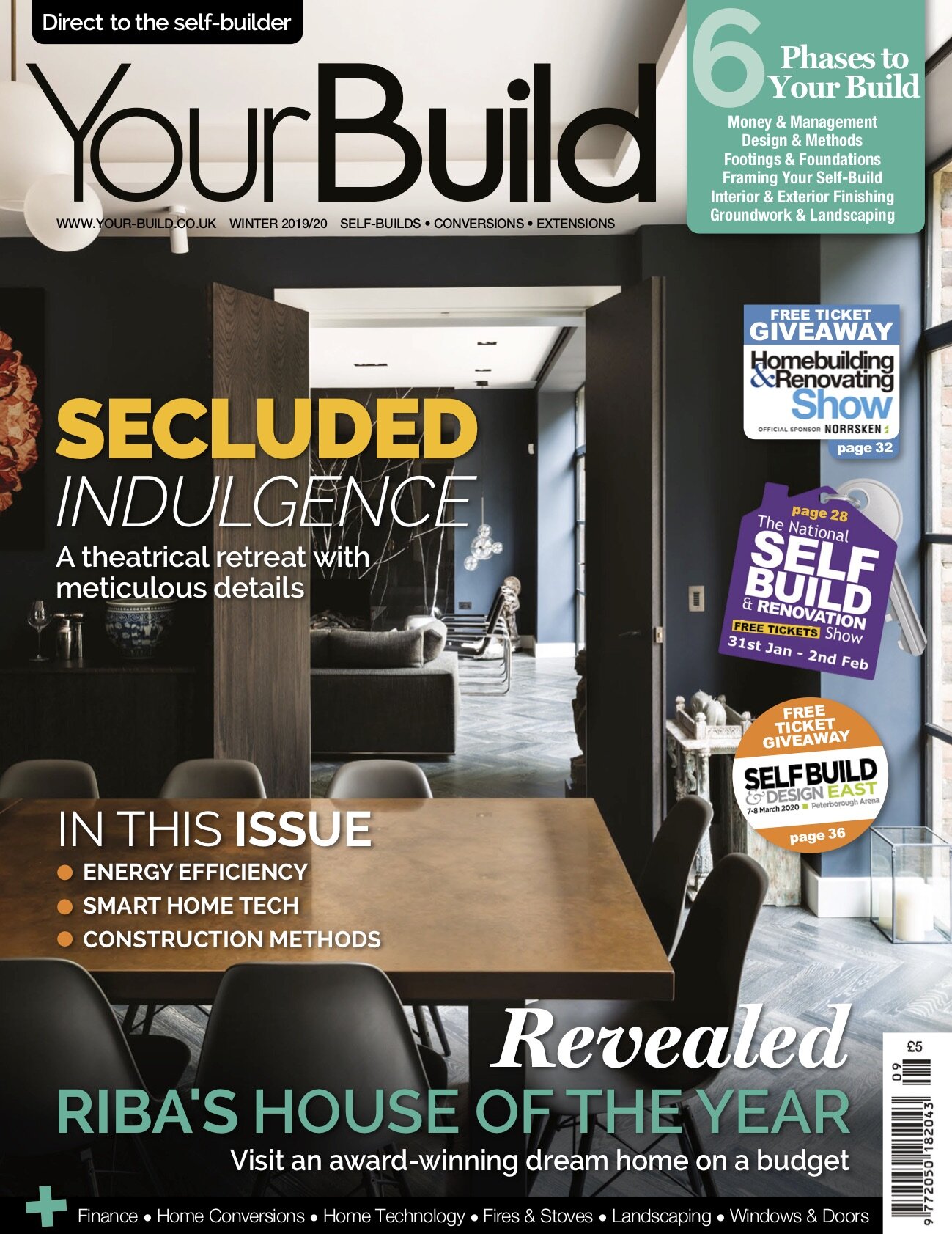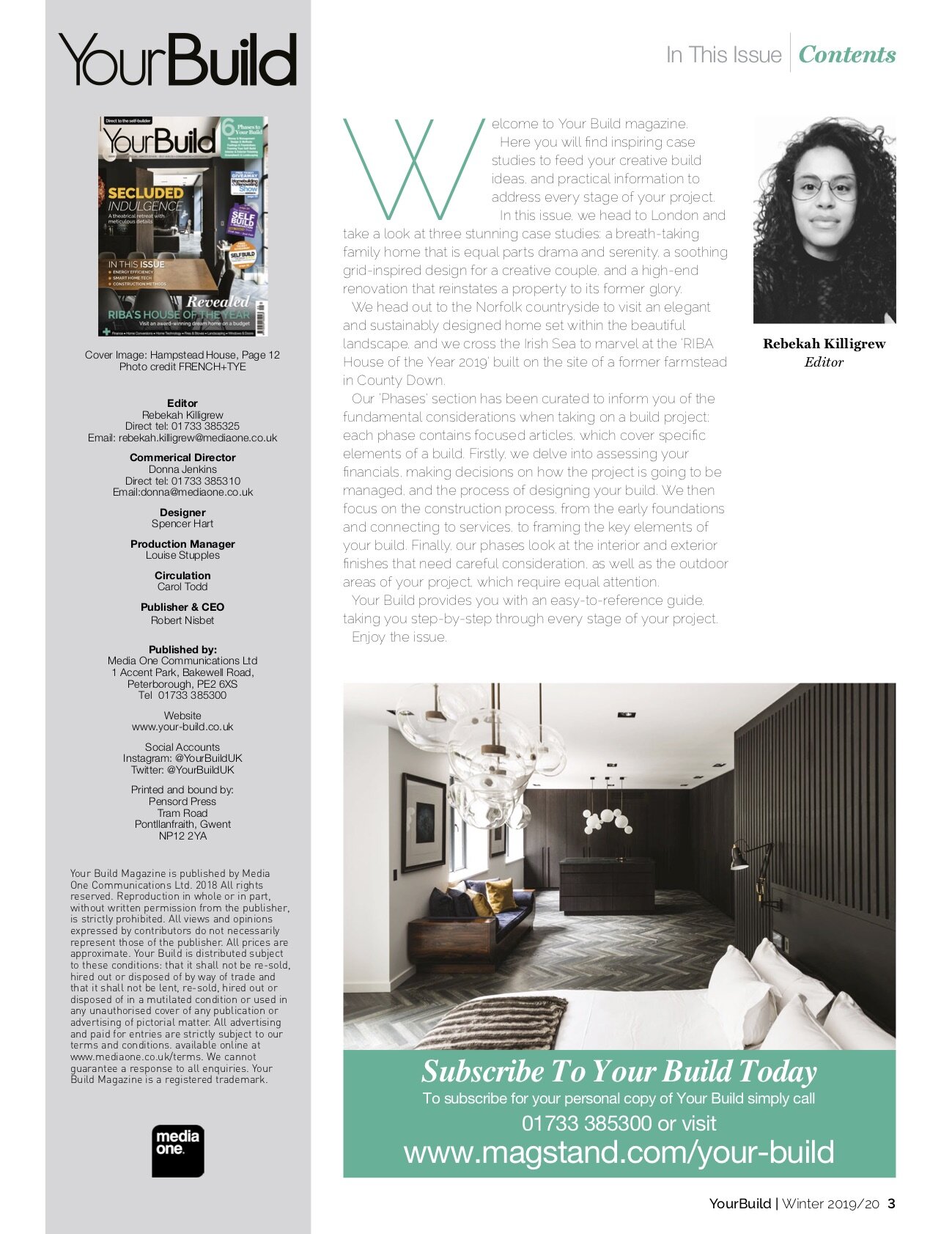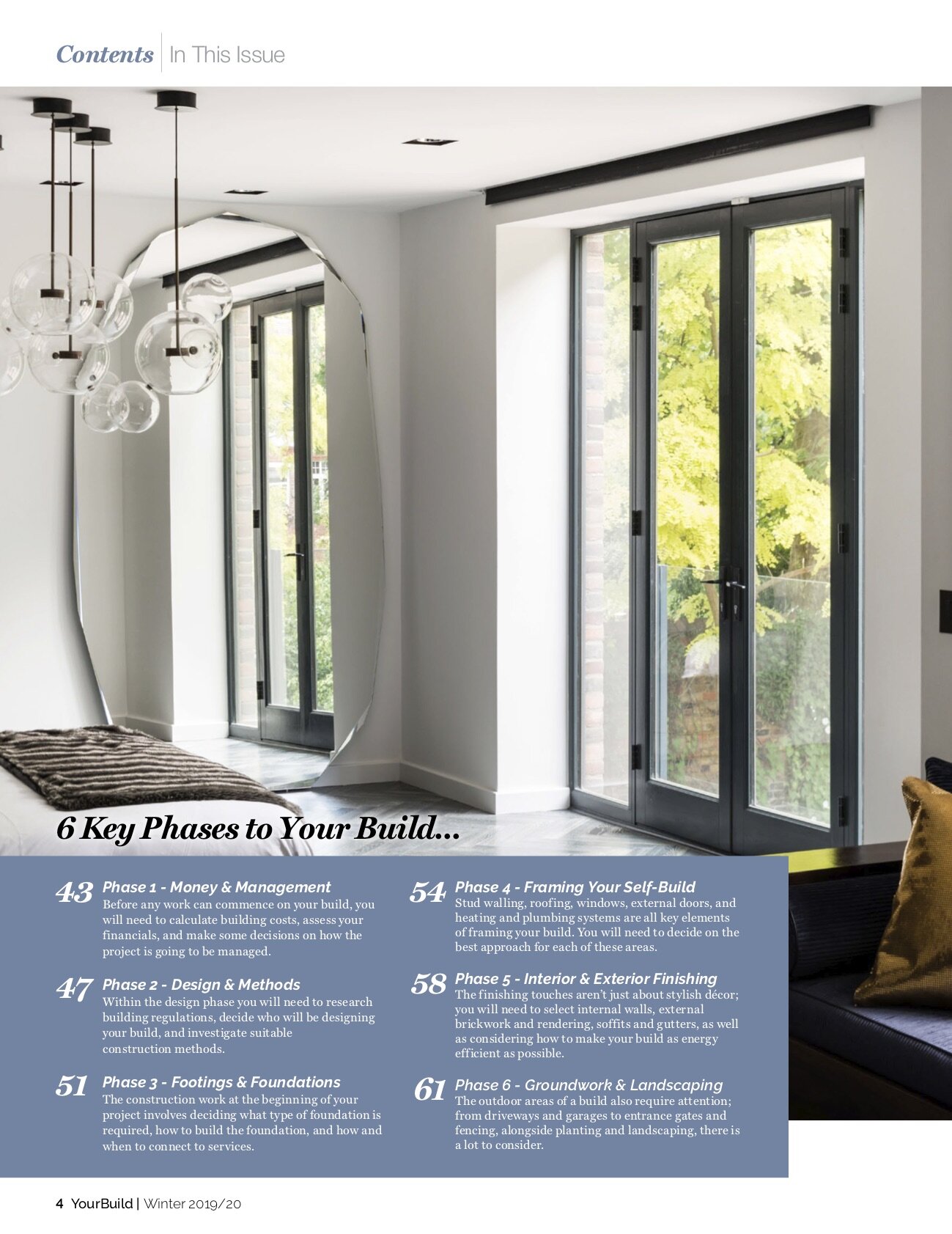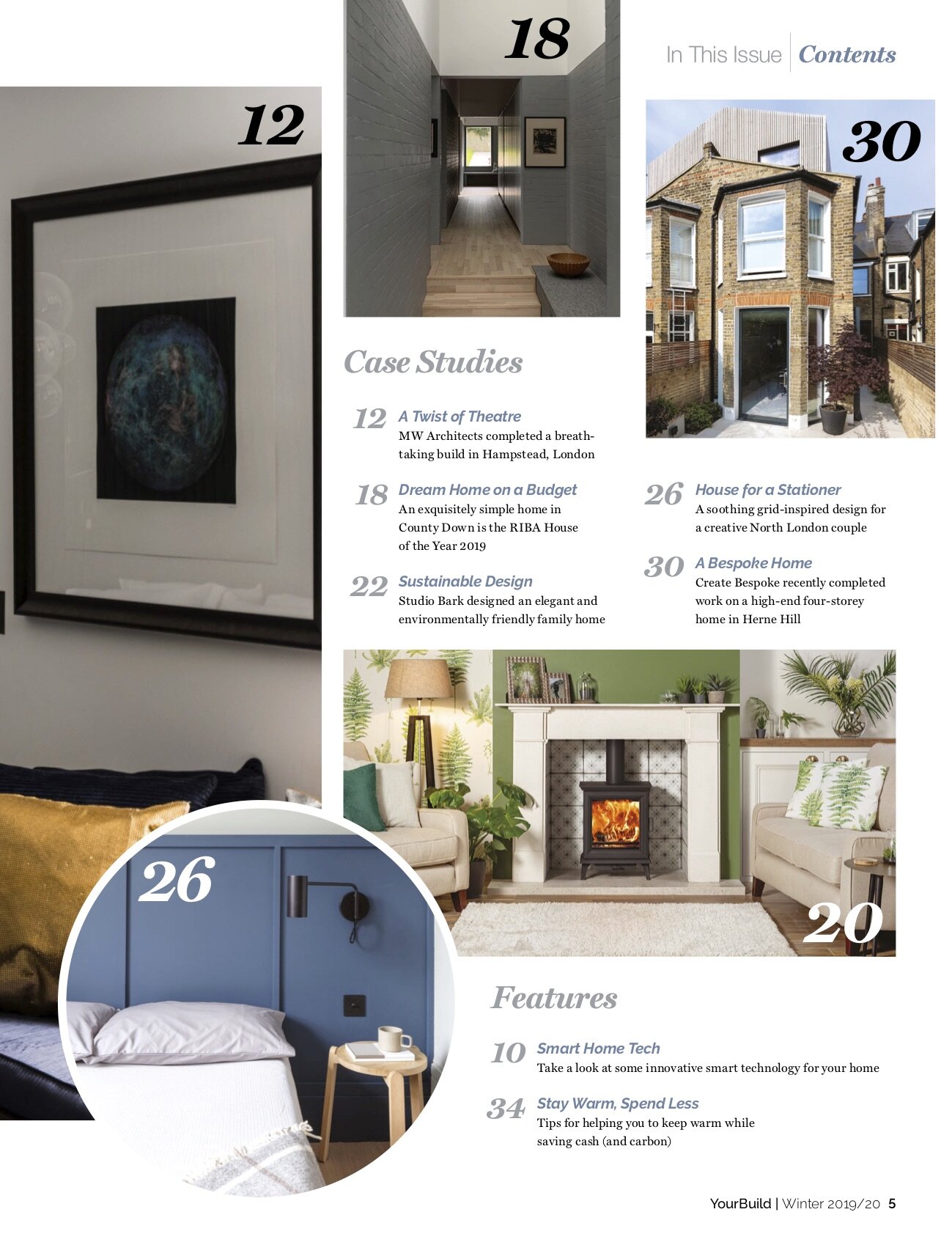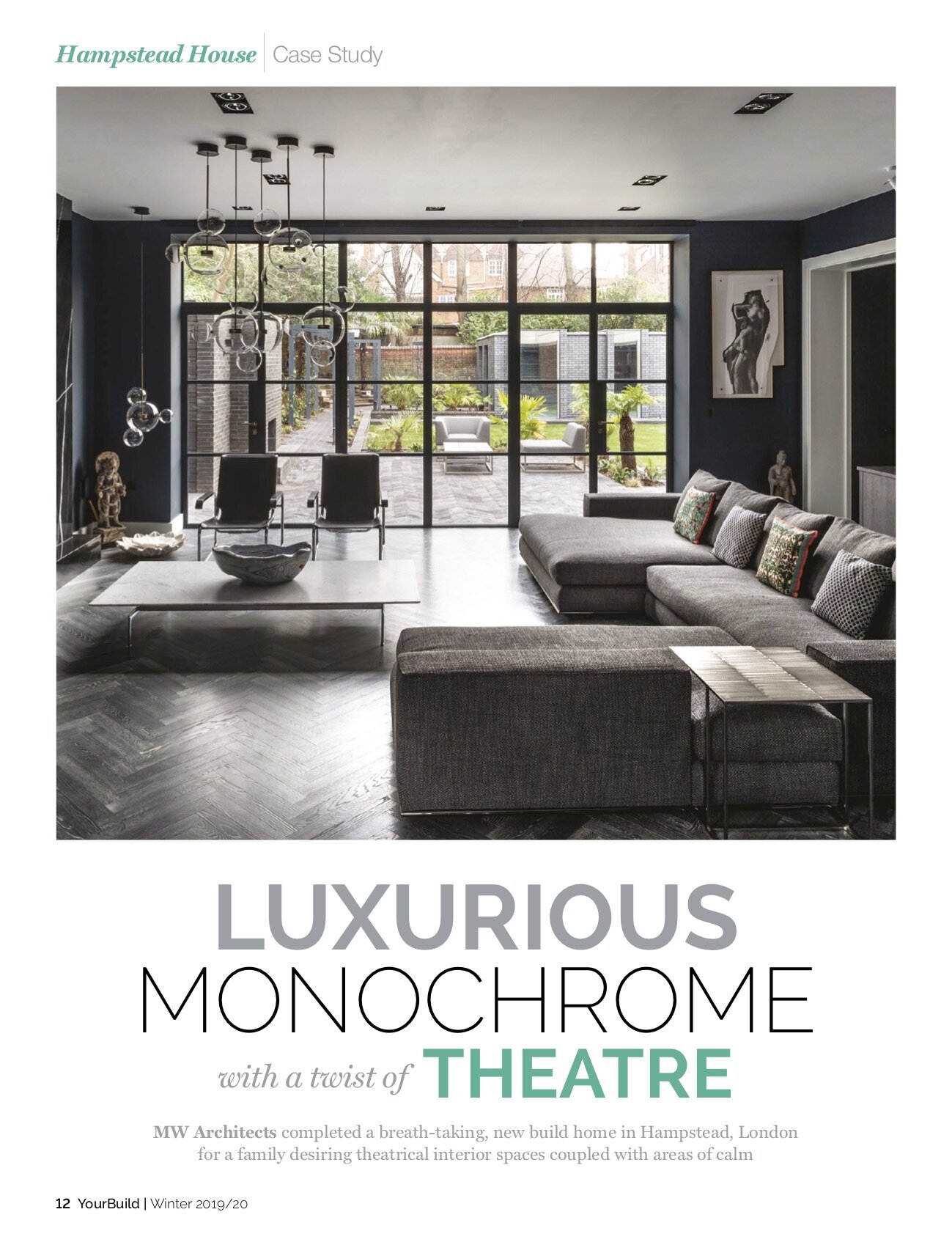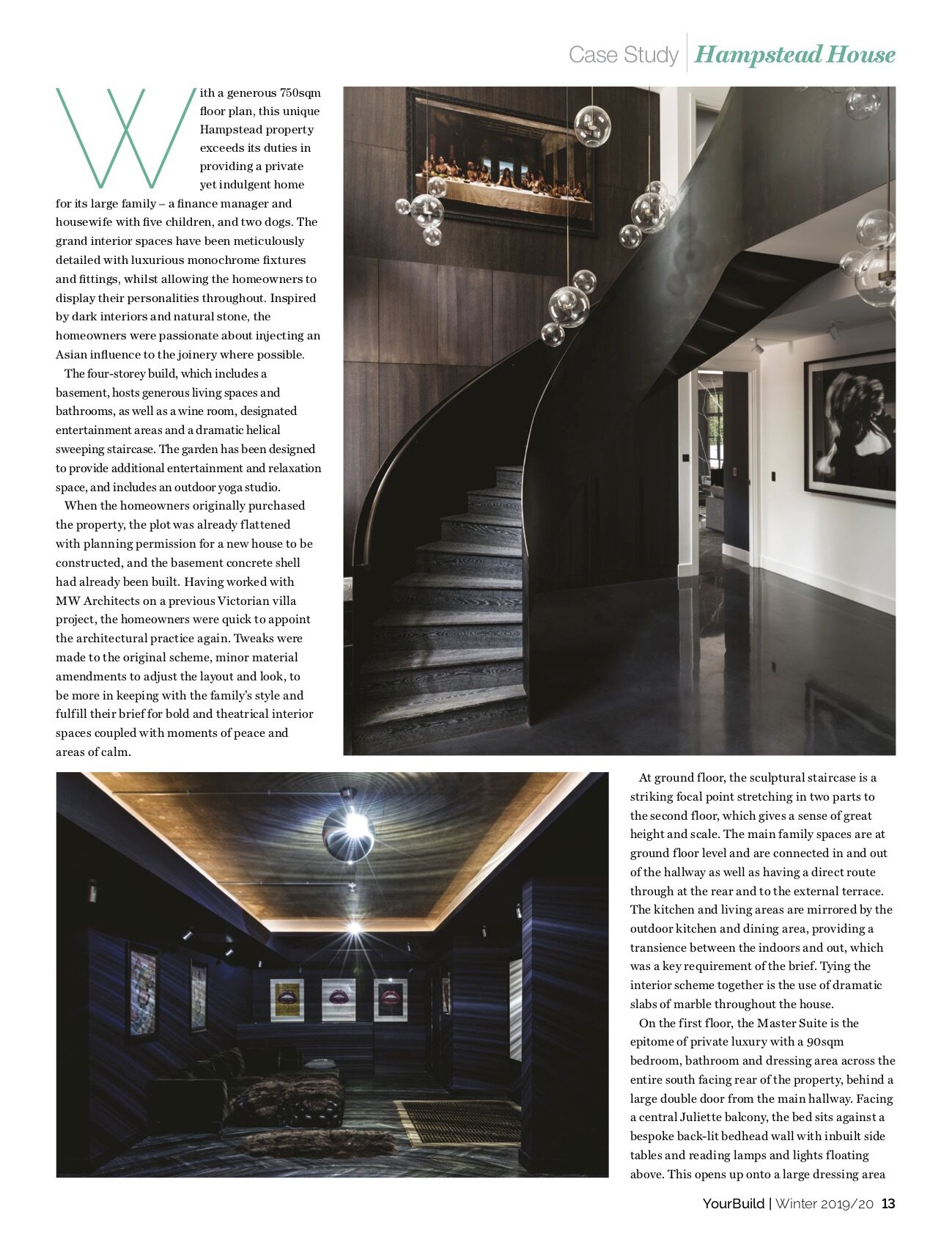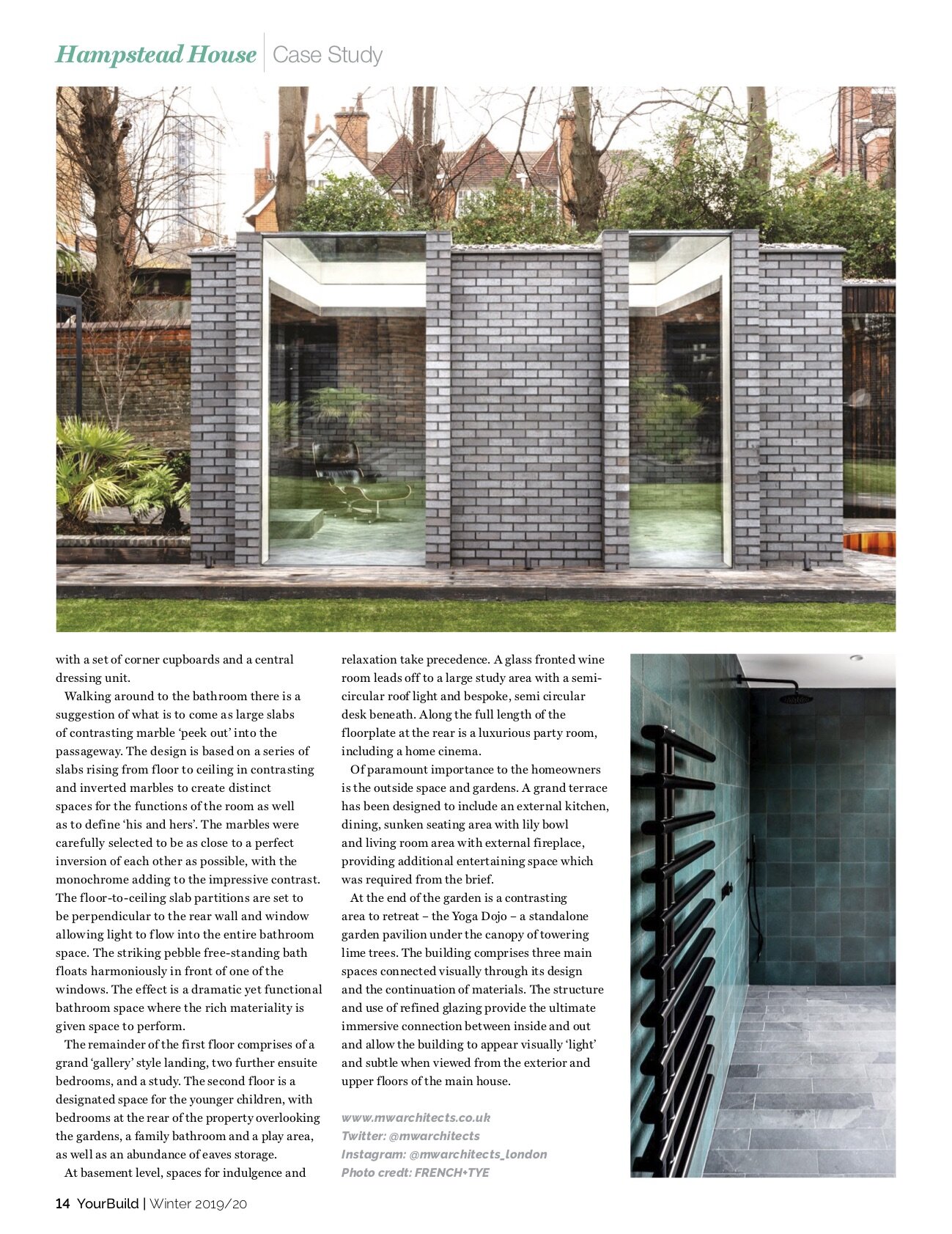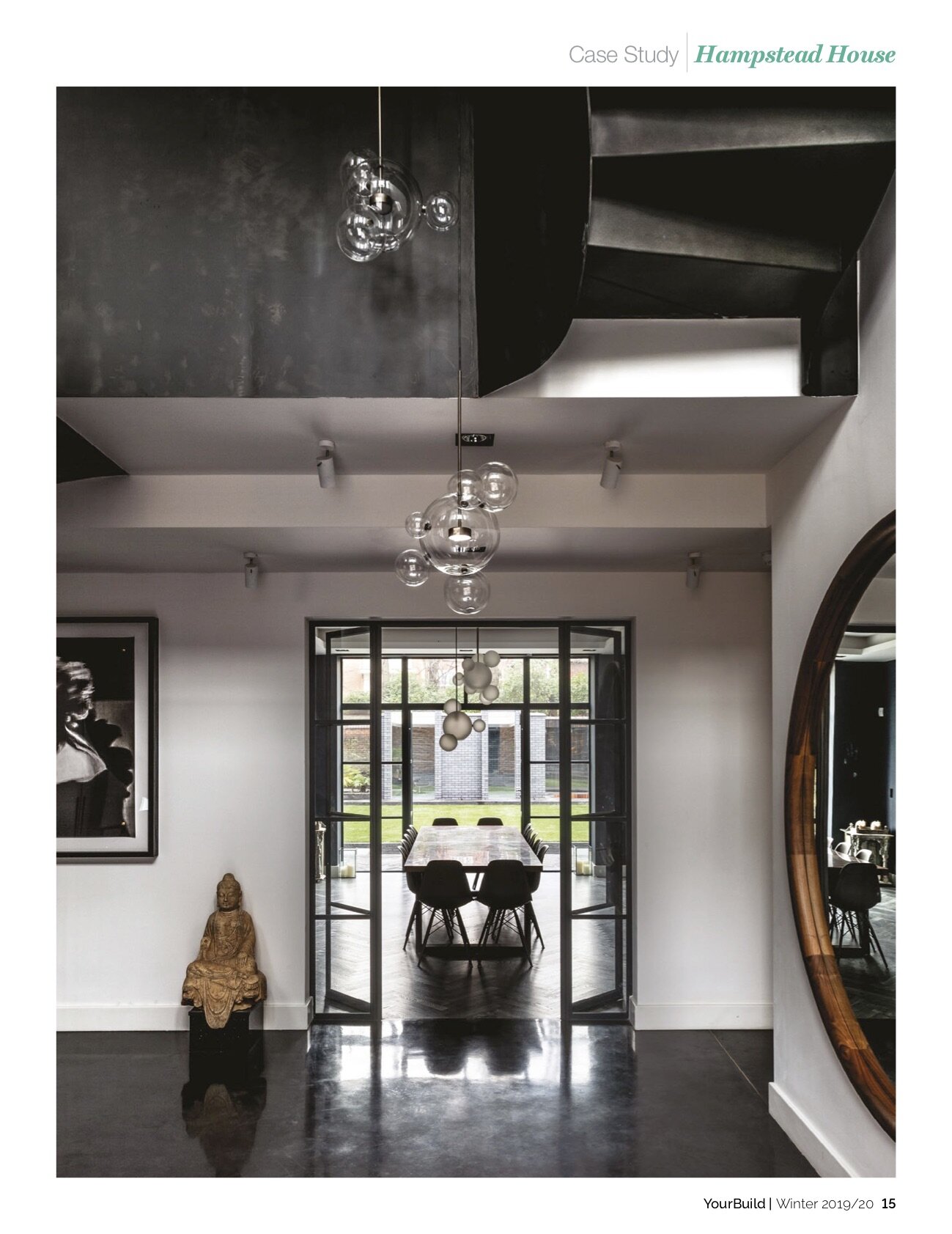Our Mackeson Road project is featured in the August 2020 edition of Self Build and Design Magazine.
Garden Rooms That Don't Require Planning Permission.
Here we showcase some of our garden rooms, none of which required planning permission, even in conservation areas!
There are a few parameters and a restrictions, but these featured garden buildings were all covered by the same permitted development as a garden shed! Our largest to date, built in the garden of Mr & Mrs Smith, is 60 sq meters and has a WC, shower, hot tub and enough space for yoga or a gym. Here we see the exterior of this project, the ‘Yoga Dojo’.
the yoga dojo // photography by french + tye
Intended to be a place for the practice of yoga and meditation it provides a distanced and calm retreat from the busy home. The building is highly engineered with precision detailing throughout and forms three main spaces connected visually through the building’s design and physically through the continuation of materials.
Yoga dojo // inside //photography french + tye
Garden rooms can be hugely varied in both scope and design. In stark contrast to the above, our Greenwich Garden room has a more rustic feel. Still containing a WC, the room was more focussed on home working than home relaxing, however it created a very relaxing place to work!
greenwich garden room // photography by french + tye
The compact outhouse transformed a cramped rear garden into a courtyard and provides a garden studio for a writer in South London. Working from home has suddenly become the reality for millions of people around the globe. Walking out of your house into an entirely separate useable space, with protection from the elements yet still in the seclusion of your home boundary, has become an increasingly tempting option for many. As the outbuilding are usually designed and built from scratch, they can be customised entirely for the needs of the family, whether it be homeschooling, a place to work, work-out or relax.
greenwich garden room // inside // photography french + tye
Maresfield Outbuilding is also built under householder permitted development. This highly engineered structure floats under the tree canopy on a concrete raft only 200mm thick with insitu exposed concrete walls. The copper roof gives the building a refined elegance that is visible from the upper floors of the house, fulfilling the brief that the arial view of the garden had to be beautiful.
maresfield outbuilding // photography by french + tye
Mainly used as a place to exercise this garden room keeps bulky equipment away from the main home. Music can be played without disturbing others and it saves on the annual gym subscription for years to come!
maresfield gardens // exterior // photography french + tye
Garden studios are a great way to add useable space to a family home. So much more than a posh shed (but with the same building rules) studios can be thermally efficient ensuring they can be used throughout the year. Studios provide a striking focal point for any garden and can be blended into the landscape using materials that match the style of the exterior and landscaping at your home. Natural or modern finishes and high specification glazing can be sure to add the wow factor. Whether you are looking for a place to entertain guests, a cover for outside dining, or just a retreat from the general buzz of family life a garden studio could be the perfect solution. We can design you a useable, flexible space that fits in with whatever your family needs.
'The Floating Playhouse'. Our Entry to the Tottenham Pavilion Competition.
In April 2020, MW Architects entered a competition to design for a new kind of public space that will be built in the Harringay Warehouse District in 2021.
In early 2020, a competition was launched to design a pavilion for a former industrial site in South Tottenham. The winning design will feature in the London Festival of Architecture and be built in 2021 by a team of volunteers.
Our newest team member, Khalid, took a lead role in our design entry, firstly by visiting the site and then drawing up a list of requirements and restrictions. Using hand drawn sketches created in studio based workshops, the ‘Floating Playhouse’ started to evolve, just as the global pandemic began.
Pencil sketches were used to pin down the project idea during these studio workshops. These sketches were then refined and coloured, to visualise the feel and come up with the title; ‘The Floating Playhouse’. The pandemic reached the UK. Every team member had to leave the studio in Brockley and continue their work from home.
A final 3D visualisation sketch was used and the proposal was passed to the rest of the team at MW Architects for final approval. The scheme envisaged to reflect both the industrial heritage of the warehouses and the character of the current warehouse living environments. Its industrial past as seen through the use of hollow steel sections and fabric-like tarpaulin roofs showcased Haringey's previous textile factories.
Supported by team member Patricia, the project evolved into a remote digital discussion due to the pandemic, embracing technology such as BIM which we use on all of our projects here at MW Architects.
Our project reimagines a new temporary cluster of external studios, performance and market spaces based on gathering spaces and community places. We attempted to design a structure that is free-form yet rigorous, modular yet structural and a framework that allows the public to fabricate their own spaces. Inspired by the artist Todd Mclellan and Architect Yona Friedman, the scheme experiments on the notion of creating adaptable and ever-changing improvised volumes floating in space. This is achieved through this use of a cubic modular structure that could be assembled and reassembled in different formations.
It is proposed that the pavilion itself will be built from hollow steel sections that create four cubic modules, these are then multiplied in great numbers: a 400mm x 400mm cube, 600mm x 600mm cube, 1200mm x 1200mm cube and a 2400mm x 2400mm cube. The spaces and shapes of the pavilion are created from a process of addition, superimposition, subtraction and splicing of these units. These volumes can then be turned into workshops, performance and market spaces by employing a mix of up-cycled, - by disassembling and reassembling recycled products - low tech materials and timber components, which would then be deployed onto the steel structure.
In order for this to be constructed, the 'Floating Playhouse' would be split into 7 mini pavilions. Each mini pavilion to be built by the warehouse community in the district (i.e. The New River Studios, Overbury Road) alongside volunteers in order to create a varied approach to each modular design. Each of these structures will be displaced to neighbourhoods across London. Following on from community events at these locations, these 7 structures will evolve and all mini pavilions will be introduced onto the designated site to create one big pavilion. Where they intersect, like a Tetris puzzle, they will produce spaces together.
This simple manipulation of orthogonal spaces creates an artificial landscape with cave-like interiors, in some parts sheltered and other parts open. Defining this dynamic three- dimensional experience opens up the opportunity for the different volumes to be explored and used in a variety of ways, inside and outside. As the pavilion will be experienced on different floor levels, the steel frame gives the impression that platforms, panels and people are floating in space. As a result, it becomes an object experienced through movement, with repetition and consistency, but with variation and disruption at every turn.
Before being judged by the Tottenham Pavilion panel, the local community will be able to vote on their favourite entry. All 166 designs are now available to view here and residents of N4, N15, Amhurst Park and Stamford Hill can register online by 8th May to vote.
Managing Clients Expectations and Realisation Using Building Information Modelling
At MW Architects all of our drawings are produced using ArchiCAD; from initial design sketches to detailed construction packages. Following its launch in 1987, ArchiCAD was the first CAD product on a personal computer able to create both 2D and 3D geometry. Now in version 23 it has won BIM product of the year 9 times on the trot. We use the program to develop all of our designs in 3D, ensuring a higher level of accuracy and quality than is achievable with the use of 2D CAD alone.
The built-in ArchiCAD features allow our clients to examine our models either wholly or in custom segments. The resulting 2D output we produce therefore consists of the highest level of accuracy possible. Our approach, made possible with the use of ArchiCAD, allows us to tackle each project with the capacity to push the boundaries whilst keeping the process efficient. With the ability to see through the entire design process from concept to project realisation within the same 3D platform, our team avoids many of the costly and timely hiccups that occur when small alterations need to be implemented once projects are on-site.
ArchiCAD simulates physical building designs within one comprehensive 3D model that integrates information from all aspects of the design. Views, plans, sections and elevations are all created automatically and remain up to date with any alterations made to the building model on which they are based. Developing a design and producing output is a fast and efficient process using this method of working . We believe it is important to make full use of the latest technologies to not only help us design, but also to communicate our ideas as effectively as possible to clients, planners, and contractors.
ArchiCAD provides the opportunity to use both real-time realistic visualisations and Virtual Reality. The use of these top end technologies allow us and clients to fully comprehend the look, feel and light quality of proposals, as well as compare different material finishes.
Our ability to export Virtual Reality enabled ArchiCAD models to BIMx, allows us to easily integrate Virtual Reality into our design process. MW Architects offer clients a complementary BIMx model that can be opened on smart phones and tablets, giving clients the opportunity to explore realistic 3D renditions of design proposals. This means they can effectively feed in to the process, whilst remaining fully informed of all developments. As well as clients, contractors also have the ability to utilise BIMx models. Not only can they be used to better understand projects, but also as a tool for communication during site meetings ArchiCAD has proven invaluable to us in all aspects of our work. With its use we feel confident in communicating our design intent, tackling challenges, and ensuring efficiency at all stages of a project. The scheduling tools help us to maintain coordinated information about sanitary ware, lighting, electrics, windows, doors, and windows, with little room for error or misunderstandings. Fully modelling and resolving our design proposals in 3D not only forces us to consider every single aspect and junction of a design, but also gives us the ability to produce high quality imagery paramount, for the successful and smooth running of every design project.
Perfectly Formed - Good Homes Magazine
Great to see MY house featured in the May 2020 edition of Good Homes magazine. Full project details on our website here.
BY Debbie Jeffrey © Good Homes magazine, as featured in the May 2020 issue, on sale March 2020.www.goodhomesmagazine.com. Photography by FRENCH + TYE.
Masters in Monochrome - Self Build and Design Magazine
House for Mr & Mrs Smith featured in March edition of Self Build and Design Magazine.
PHOTOGRAPHY BY FRENCH + TYE
See Projects for full details.
Elgin Avenue - to be featured in Don't Move Improve 2020
Don’t Move Improve 2020. Photography by French + Tye.
Real Homes - Greenwich Garden Studio
Our garden studio for a writer in South London, has been featured in Real Homes magazine. When space is short in your home, creating the extra room you need outside could be the answer.
REAL HOMES. SARAH WARWICK. PHOTOGRAPHS BY FRENCH + TYE
See Projects for full details and before and after photos.
REAL HOMES. SARAH WARWICK. PHOTOGRAPHS BY FRENCH + TYE
As space is at a premium the partition separating the two spaces contains a Barbican sink within the stud work on the WC side and a series of shelves and compartments for printers and fold down desks on the reading room side.
REAL HOMES. SARAH WARWICK. PHOTOGRAPHS BY FRENCH + TYE
Your Build - New Build House for Mr & Mrs Smith
Our new build house in Hampstead has been featured as a case study in Your Build. The four storey build includes generous living spaces and a striking sculptural staircase. Outside, a grand terrace includes an external kitchen and at the end of the garden - the Yoga Dojo - a stand alone pavilion nestles under a canopy of lime trees. Full project details can be found here.
Your Build. Winter 2019/20. Photos by FRENCH & TYE.





